
Melaleuca linariifolia is a plant in the myrtle family Myrtaceae, and is endemic to eastern Australia. It is commonly known as snow-in-summer, narrow-leaved paperbark, flax-leaved paperbark and in the language of the Gadigal people as budjur. A hardy plant, it flowers prolifically in late spring or summer, making it a popular garden shrub or small tree in temperate places. Melaleuca trichostachya is a similar species but its leaves are arranged differently and the fruits have projecting valves.
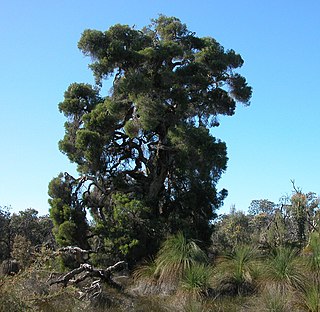
Melaleuca preissiana, commonly known as stout paperbark, modong or moonah, is a plant in the myrtle family, Myrtaceae and is endemic to coastal areas of southwest Australia. It is a shrub or small tree with papery bark, small leaves and spikes of usually white flowers. It occurs chiefly in areas that are seasonally wet.

Melaleuca leucadendra, commonly known as weeping paperbark, long-leaved paperbark or white paperbark is a plant in the myrtle family, Myrtaceae and is widespread in northern Australia, Southeast Asia, New Guinea and the Torres Strait Islands. It is a tree, sometimes growing to more than 20 m (70 ft) with a trunk covered with thick, white, papery bark and weeping thinner branches. It has a long flowering season, can flower at almost any time of the year and is often grown as a tree in parks and on roadsides. It was the first melaleuca to be described and was described from a specimen growing in Indonesia.

Melaleuca lanceolata commonly known as black paperbark, moonah, Rottnest Island teatree and western black tea tree is a plant in the myrtle family, Myrtaceae and is native to Australia where it occurs in Western Australia, South Australia, Victoria, New South Wales and Queensland. It is a densely foliaged tree with rough bark, which flowers prolifically in summer.

Melaleuca viridiflora, commonly known as broad-leaved paperbark, is a plant in the myrtle family Myrtaceae, and is native to woodlands, swamps and streams in monsoonal areas of northern Australia and New Guinea. It is usually a small tree with an open canopy, papery bark and spikes of cream, yellow, green or red flowers.

Melaleuca dissitiflora, commonly known as creek tea–tree, is a plant in the myrtle family, Myrtaceae and is native to Australia. It occurs in the drier parts of Queensland, the Northern Territory, South Australia and Western Australia. It grows in places like sandy creek beds and rocky gorges but it may have potential as a more productive source of "tea tree" oil than the usual Melaleuca alternifolia. It is closely related and very similar to Melaleuca linophylla with its papery bark, narrow leaves and loose spikes of creamy-white flowers but its flowers are larger, the stamens are longer and there are more stamens per bundle than in that species.

Melaleuca hnatiukii is a plant in the myrtle family, Myrtaceae and is endemic to the south of Western Australia. It is a medium to large shrub with arching branches, prickly tipped leaves and creamy-white heads of flowers in spring or early summer.
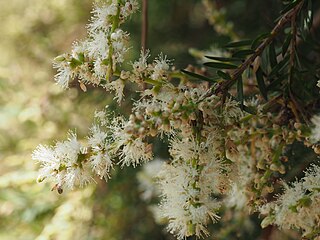
Melaleuca decora, commonly known as the white feather honeymyrtle, is a plant in the myrtle family, Myrtaceae and is native to eastern Australia. It is a large shrub to small tree with papery bark, lance-shaped leaves and sweet-smelling, creamy-coloured flowers in summer. It grows in near-coastal forest and swamps in New South Wales and Queensland.

Melaleuca dealbata, commonly known as karnbor or blue paperbark, is a plant in the myrtle family, Myrtaceae and is native to tropical areas in northern Australia, New Guinea and Indonesia. It is a medium to large leafy tree, growing in wet areas such as on the edges of coastal lagoons. It has papery bark, relatively large, blue-green leaves and spikes of cream-coloured flowers over a long period.

Melaleuca argentea, commonly known as the silver cadjeput, silver-leaved paperbark, silver cajuput, or mardderr in the Kunwinjku language, is a plant in the myrtle family, Myrtaceae and is endemic to northern Australia. It is a common tree along river banks or around swamps in the tropics. It has papery bark and weeping foliage and has been the subject of important scientific research.

Melaleuca nervosa, commonly known as fibrebark, is a shrub or tree in the myrtle family Myrtaceae and is endemic to northern Australia. It is a narrow-leaved, tropical paperbark with yellow-green and red-flowering forms. As with some other melaleucas, this species has many uses to Indigenous Australians.
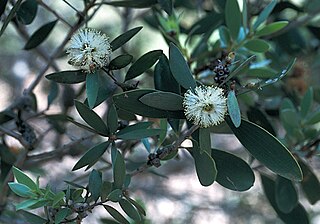
Melaleuca arcana is a small tree or large shrub in the myrtle family, Myrtaceae and is endemic to Cape York Peninsula in northern Australia. It has papery bark and small heads of white flowers in summer.
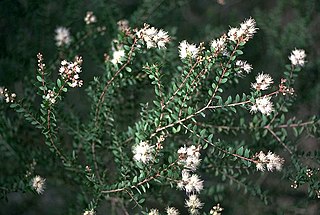
Melaleuca cheelii is a plant in the myrtle family, Myrtaceae and is endemic to the Wide Bay–Burnett region of Queensland. It is a shrub or tree to 10 m (33 ft) with white flowers and papery bark. It has been classified as "near threatened" by the government of Queensland.
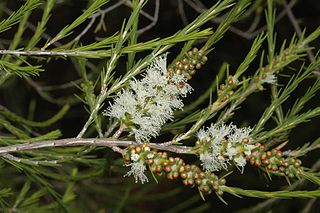
Melaleuca densispicata is a plant in the myrtle family Myrtaceae and is native to Queensland and New South Wales in Australia. It is a dense, woody shrub or tree with papery or scaly bark, sharp pointed leaves and dense flower spikes. It is uncommon throughout its range and was not formally described until 1984.

Melaleuca diosmatifolia, commonly known as rosy paperbark and pink honey-myrtle is a plant in the myrtle family, Myrtaceae and is native to Queensland and New South Wales in Australia. It was formerly known as Melaleuca erubescens but is not closely related to Melaleuca diosmifolia although the species name has the same meaning. It has pointed, non-prickly leaves and cylindrical spikes of pink or purple flowers.

Melaleuca fluviatilis is a plant in the myrtle family, Myrtaceae and is endemic to northern Queensland in Australia. It is a tree with papery bark, narrow leaves and spikes of white or creamy-coloured flowers, usually growing along streams and rivers. It is common in tropical areas and is sometimes confused with Melaleuca argentea although it lacks that species' silvery foliage.

Melaleuca parvistaminea is a plant in the myrtle family, Myrtaceae, and is endemic to the states of New South Wales and Victoria in Australia. It has hard, rough bark, cream coloured flowers and leaves in whorls of three around the stems.

Melaleuca stenostachya, commonly known as fibre-barked teatree or straight teatree is a plant in the myrtle family Myrtaceae and is native to the Cape York Peninsula in northern Australia, the gulf country of the Northern Territory and the south of Papua New Guinea. It is closely related to Melaleuca dealbata but can be distinguished from that species by the wide separation of the flowers in the inflorescence.
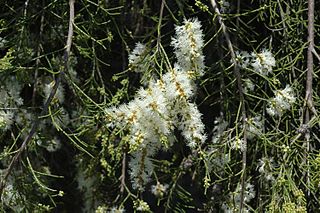
Melaleuca tamariscina, commonly known as bush-house paperbark or tamarix honey-myrtle is a plant in the myrtle family, Myrtaceae and is endemic to central Queensland in Australia. It grows to the height of a small tree with small, scale-like leaves that are pressed against the branches, and has a papery bark and a weeping habit.

Melaleuca tortifolia is a plant in the myrtle family, Myrtaceae and is endemic to a small area on the Northern Tablelands of New South Wales in Australia. It has egg-shaped, twisted leaves and heads, or short spikes of white or creamy-white flowers in December. It is classified as a threatened species.






















